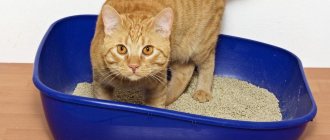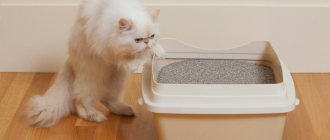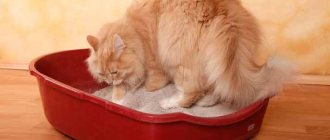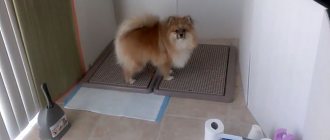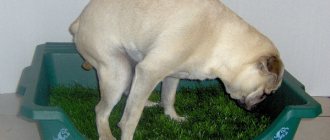There are a lot of people in the world who feel sorry for and warm animals, including homeless and defenseless ones. It happens that kittens are simply found, but they no longer have a mother cat. Then the care of the foundlings falls on the shoulders of those who want to help.
How to get a kitten to go to the toilet? In the first three weeks of life, kittens cannot take care of themselves. Then the act of defecation and urination is carried out only with active stimulation of the corresponding zones. Typically, the mother cat carefully licks the kittens under the tail, thereby causing emptying of the bladder and rectum. It is somewhat more difficult for a person to organize the process, especially if he has no experience in caring for kittens.
Recommendations
How to get a kitten to go to the toilet? After feeding, carefully and at the same time firmly fix the pet so that it cannot slip out. The fingers of the hand should be located simultaneously under the chest and stomach, so that the tail is towards the caregiver. You need to put a damp, warm napkin on your other hand, preferably white, but you can also use light colors, because it’s easier to tell on a light fabric whether the kitten went to the toilet or not.
Next, you need to stimulate the baby to urinate. Do not apply strong pressure and wipe the area from the lower abdomen to the anus. If the kitten went to the toilet (did not defecate - wiping continues), then you need to move to the anal area, doing a specific massage. Usually the effect occurs within a minute. But it happens that animals cannot go even after several feedings. Then you need to show him to a veterinarian.
After the job is done, you must first wipe the contaminated areas of the skin with a clean edge of the napkin (urine and feces are irritating, and dermatitis or a genitourinary tract infection may develop at the site of their appearance, since there is no strong immunity yet formed). It is also necessary to dry wet areas. This procedure is done for each kitten.
If there are several children, separate napkins are allocated for each of them (these can be pieces of bandage, gauze, cotton pads, which are thrown away after use). The whole procedure must take place in a warm room without drafts, otherwise the baby will become hypothermic and die.
First aid
In a situation where a cat cannot pee, what should you do at home? First, it’s worth checking whether anything has changed in the cat’s life:
- castration;
- moving;
- change of owners;
- change of feed;
- low activity after illness;
- drug treatment;
- other surgical interventions.
If none of this has happened in the cat’s life, and the behavior is very different from usual, it is important to help him.
First aid
First aid:
- Place a warm heating pad or compress on your stomach and perineal area. Make sure that the cloth or heating pad is not too hot. It is necessary to warm, but not burn the abdominal cavity;
- place the animal in a bath or basin at a comfortable temperature. It is necessary to ensure that the water does not reach the heart area;
- control the volume drunk. The animal must drink a lot. If it refuses, it is allowed to pour in a little from a pipette.
A good way to help him cope with his illness is to play with him if he is active. But you shouldn’t force your cat to do this, especially if it’s hard for him.
Cases of constipation in kittens per month of life
The causes of constipation are varied, but most often occur due to improper feeding, since the stomach does not yet accept too solid food (it is accustomed to breast milk or formula), the presence of infestation or hair in the stomach (long-haired cats suffer more often).
It is easy to detect: the baby does not go to the toilet for more than two days, the tummy begins to increase in size, the animal is worried and meows pitifully, the kitten can squat into a defecation position, but nothing comes out (the discharge can be the size of a bean seed).
Diet for difficulty urinating
It doesn't matter what diagnosis the cat was given. If she has difficulty going to the toilet, this is a reason to reconsider her diet. It is necessary to exclude cheap “economy” brands of food from her diet. They often irritate the mucous membranes, kidneys and urinary tract, causing additional pain in the cat’s body.
These foods contain a lot of salt, preservatives and dyes. The meat content there will be in last place, if it was used at all in the production of feed. It is recommended to switch the animal to expensive food of special brands designed specifically for animals with urological diseases.
It is strictly forbidden to give your cat:
- pork;
- salt;
- milk;
- raw meat;
- raw fish.
Some foods, such as pork or milk, will make the urine thicker, making it more difficult for you to pass out. Protein foods will overload the kidneys, and raw fish will create the likelihood of kidney stones.
The diet must be agreed with your doctor
Ways to help a kitten get things done
How to help a kitten go to the toilet? You can use enemas, the most effective are Microlax for children from zero years of age (after insertion, the anus must be closed with the tail, otherwise the microenemas will be of no use, and wait a little). In addition to the enema, massage the tummy in a clockwise circular motion. If feces appear from the anus, but cannot come out on their own, you need to begin to quietly and very carefully push it out. The kitten needs to be shown to a veterinarian not only if he was unable to go, but also for preventive purposes.
Outdoor toilet
How to train a kitten to go to the toilet in a private house? There are two methods to teach your baby to go to the toilet outside using a tray. The first is the gradual development of a habit. The second is the most common, but you need to monitor the animal’s reaction. If the baby looks for a dark corner after feeding, he tries to show that he wants to go to the toilet, in which case he needs to be taken outside. The actions must be repeated so that he can get used to doing his business near the house.
How to make a kitten go to the toilet if he is hiding? Close the doors before feeding, then he will be in sight. You can walk the cat after each feeding and wait for the result. This will have a good effect on digestion. Within a few days, you will develop the reflex to ask to go outside.
What will the veterinarian do?
The first thing the doctor will do is insert a catheter to alleviate the animal’s health condition and remove fluid. Only a professional is allowed to install it - at home, trying to install a catheter can result in serious injury to the cat and scratched hands of the owner.
Then the cat’s bladder is washed with antiseptics. This is a rather painful procedure, so it is performed under general anesthesia. Once both procedures are completed, the specialist will perform a series of tests to determine the cause of urinary retention.
It is important to take tests and, if necessary, conduct additional ultrasound and other recommended procedures. You cannot treat an animal at random without making a correct diagnosis.
What tests can be taken:
- blood biochemistry and hormone levels;
- general urinalysis, acid-base balance, acetone level;
- Ultrasound;
- X-ray;
- a study aimed at comparing fluid intake and excretion.
Attention ! The catheter is sewn in only for a few days. If the specialist said to keep the catheter for 4 days, then after this period you need to come in to remove the device. In addition, frequent or prolonged insertion of a catheter can negatively affect health and cause swelling and swelling of the urinary tract.
Catheterization of a cat, putting on a collar
While the catheter is being sewn, you need to keep the animal in a special collar so that it does not injure itself trying to get out the interfering foreign body.
Toilet in the apartment
How to train a kitten to use the toilet in an apartment? Not all owners have the opportunity to take their pet outside after each feeding, especially since in the courtyard of a multi-story building there are many hidden dangers, ranging from physical injuries to infectious and invasive diseases. Therefore, it is advisable to accustom the kitten to the toilet in the apartment. To develop a strong habit, you need to take your baby to the place where the tray will be or is already located. When choosing a place for a cat's litter box, you need to take into account several nuances: cats do not like to be looked at during such a delicate task, the tray should be easy to get from this place.
Self-diagnosis
If the owner suspects problems in the functioning of the urinary system of his beloved pet, he should provide him with first aid. If it is not possible to consult a veterinarian, then you should examine the animal yourself at home to determine the degree of fullness of the bladder.
To do this, place your furry pet on its paws and clasp it with both hands. After this, carefully palpate the bladder, which is located on a line perpendicular to the testes. In case of severe inflammation, the cat will not allow you to do this, and this is a clear signal that it urgently needs to be taken to the clinic.
We invite you to read: Stronghold for cats - instructions for use of the drug
If you do manage to examine the bubble, try to estimate its size and also determine how dense it is. A healthy cat's bladder is soft to the touch and the size of a nut.
A hard or enlarged bladder indicates the development of serious problems, so take your pet to a doctor right away. To alleviate the cat's severe condition, try placing a heating pad on her perineum and stomach.
Important: some pet owners think that if dangerous symptoms appear, they should help the suffering pet by massaging the cat’s belly. But in fact, such actions can only worsen the problem.
Kitten training
How to get a kitten to go to the toilet if the previous owners did not teach him to go to the litter box? The main thing is not to get upset. During the day, you should watch your pet and take it to the place where the tray should be located. If the pet made a puddle or something else: for example, a person went into another room for literally half a minute or absent-mindedly missed the moment - then it is imperative to immediately clean up after the baby and clean the area with a strong-smelling detergent (if this is not done, the wrong habit may form) . Cats use their scent to navigate where to go to the toilet, and the kitten will return to this place again and again, rather than go to the litter box.
Selecting a location
How to train a kitten to use a litter tray? If you are just planning to take a baby, then you need to immediately approach the responsible task correctly. The first purchase for a kitten, of course, is a tray, which it is advisable to choose correctly.
Let's look at some types:
- The cheapest option is a plastic tray with low sides. It washes well and takes up little space, but a significant drawback is that it is used together with filler granules, which the kitten can scatter or eat (you need to think about eating in advance).
- Tray with mesh. Can be used without filler. It has high sides. Cats like these because they look like boxes.
- Tray in the form of a house (closed type). The advantage of such a device is its aesthetics, the disadvantage is the high cost of the device.
- Self-cleaning tray. This option has a number of positive qualities: the cleanliness of the tray does not require the owner’s attention; no odor; Four pets can go into this tray; presence of a motion sensor; safety of capsules. The negative aspects are: connection to water supply and electricity, noisy flushing, which can frighten the animal.
How to help a kitten?
How to get a kitten to go to the toilet? If the kitten is already familiar with the place where he needs to go to the toilet, but is not yet used to it, you need to wait until the baby fusses or starts digging. Then it is necessary to urgently carry it into the tray and not release it until the desired effect is achieved. The animal will monitor the reaction of the owner or mistress. You can praise him and pet him. There is no need to remove the contents of the tray right away: the baby will get used to it and remember the place faster. The main thing is not to use cruelty as punishment (deprive the kitten of water or food, leave it alone in the room, beat or push the kitten).
You need patience and perseverance - then the kitten will be everyone’s favorite, devoted to you for the rest of its life.
Danger of difficulty urinating
If treatment is not started in time, the animal will begin to lose weight and activity, hair will grow, and the disease will have time to become chronic. These include pain every time you try to pee, restless or exhausted behavior. Retention of urine in the body can cause intoxication of the cat and serious consequences for its body.
Some diseases, such as urolithiasis, can cause complete blockage of the urinary tract. This will provoke inflammation and rupture of internal organs, resulting in the death of the pet.
It is advisable to conduct regular examinations with a veterinarian and monitor the condition of the cat. Any disease, even not too serious, can become purulent, chronic or life-threatening for your pet. To avoid this, it is important to monitor the animal, and at the first sign of strange behavior, it is better to immediately contact a specialist.
